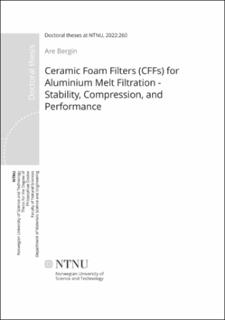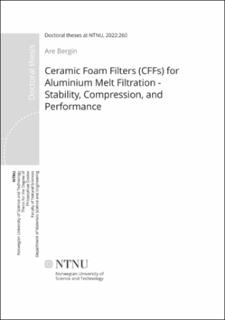| dc.contributor.advisor | Aune, Ragnhild E. | |
| dc.contributor.advisor | Arnberg, Lars | |
| dc.contributor.advisor | Akhtar, Shahid | |
| dc.contributor.author | Bergin, Are | |
| dc.date.accessioned | 2022-09-13T13:08:31Z | |
| dc.date.available | 2022-09-13T13:08:31Z | |
| dc.date.issued | 2022 | |
| dc.identifier.isbn | 978-82-326-6022-3 | |
| dc.identifier.issn | 2703-8084 | |
| dc.identifier.uri | https://hdl.handle.net/11250/3017560 | |
| dc.description.abstract | During aluminium production, the molten aluminium will necessarily include a certain amount of impurities, including non-metallic inclusions, i.e., solid objects immersed in the melt. These inclusions are known to be detrimental both for further processing, such as rolling and extrusion, as well as for the final product’s mechanical properties. Therefore, reducing them to a minimum is essential. A commonly applied method for inclusion removal is filtration, e.g., with the use of ceramic foam filters (CFFs), where improvements in filtration efficiency are desired.
The main focus of the present project has been to test the suitability and performance of new and innovative CFFs, i.e., CFFs not commercially available, with the overall aim of improving filtration efficiency. The project was started by testing the chemical and thermal stability of the filters when they were subjected to conditions comparable to those in a casthouse. Thereafter the filtration performance of promising filter candidates was tested in a pilot-scale filtration campaign replicating casthouse conditions.
The chemical stability of filters was analysed by performing immersion trials, where the filters were immersed in melts of pure aluminium (~ 99.5 wt.-% Al) and an aluminium-magnesium alloy (~ 2.2 wt.-% Mg) at 730 ℃, whereby the melt compositions were analysed by spectroscopy and the filters examined by imaging and x-ray techniques. In addition, any formation of phosphine gas (PH3) was measured using Dräger-Tubes®. Filters produced with a phosphate binder were observed to react with magnesium in the melt, with increasing severity for increasing magnesium concentrations. Reactions between the melt and the filter foam were even observed with magnesium in trace element concentrations (0.00035 wt.-% Mg). This observed filter degradation was accompanied by diffusion between the filter and the melt, where magnesium was observed to diffuse into the filter and phosphorus into the melt. Upon filter cooling in air after testing, the degraded filter reacted with the humidity in the air, emitting phosphine gas at amounts exceeding recommended exposure limits. The new and innovative filters, produced without a phosphate binder, showed no indications of being reactive in molten aluminium with the present immersion tests.
The thermal stability of the filters was investigated through compression strength testing, where compression strength at room temperature served as a reference. Compression was further performed at elevated temperatures by heating filters at 800 ℃ and performing compression tests in air at a filter temperature of ~ 730 ℃. A method was designed to perform compression of filter samples submerged in molten aluminium, where the filters were tested in melts with the same compositions as in the chemical stability tests. Through analysis of load-displacement curves it was observed that the strengths, with a few exceptions, decreased for testing at elevated temperature compared to room temperature testing. The testing of filter samples submerged in molten aluminium led to a further decrease in the compression strength. There was a significant difference in compression strength between the commercial filters and the new and innovative sintered alumina filter, which showed a higher strength. No difference in strength was seen between the two melt compositions at the present filter submersion time of 5 minutes.
The filtration performance of a series of CFFs was also tested in a pilot-scale loop filtration setup, using 8 tons of a 6082 aluminium alloy (with extra additions of magnesium) per trial. Some trials were run with additions of grain refiner to investigate its effect on filtration efficiency, while others were not. The filtration performance was evaluated by continuously measuring the melt quality before and after the filter with two Liquid Metal Cleanliness Analyzers (LiMCAs) and the pressure drop over the filter using lasers. Furthermore, three PoDFA-sampling sequences were performed per trial, and after each trial, the spent filters were analysed by light optical microscopy (LOM) and scanning electron microscopy (SEM). It was concluded that the filtration performance of the different filters was similar to each other, with filtration efficiencies in the upper range of what was expected. Additionally, in relation to the previously performed chemical stability immersion tests, a commercial filter of sintered alumina and silica showed indications of silicon depletion upon spent filter analysis. | en_US |
| dc.language.iso | eng | en_US |
| dc.publisher | NTNU | en_US |
| dc.relation.ispartofseries | Doctoral theses at NTNU;2022:260 | |
| dc.relation.haspart | Paper 1:
Bergin, Are; Voigt, Claudia; Fritzsch, Robert; Akhtar, Shahid; Arnberg, Lars; Aneziris, Christos G; Aune, Ragnhild Elizabeth.
Experimental Study on the Chemical Stability of Phosphate Bonded Al2O3-based Ceramic Foam Filters (CFFs). Metallurgical and Materials Transactions B 2021 ;Volum 52. s. 2008-2025
https://doi.org/10.1007/s11663-021-02144-3
This article is licensed under a Creative Commons Attribution 4.0 International License CC BY | |
| dc.relation.haspart | Paper 2:
Bergin, Are; Fritzsch, Robert; Akhtar, Shahid; Arnberg, Lars Erik; Aune, Ragnhild Elizabeth.
Silicon Depletion and Filtration Conditions of Ceramic Foam Filters (CFFs) during Aluminium Melt Filtration. Light Metals 2024
https://doi.org/10.1007/978-3-031-50308-5_120 | |
| dc.relation.haspart | Paper 3:
Bergin, Are; Fritzsch, Robert; Akhtar, Shahid; Arnberg, Lars; Aune, Ragnhild Elizabeth.
Compression Testing of Ceramic Foam Filters (CFFs) Submerged in Aluminium at Operating Temperature. The Minerals, Metals & Materials Series 2021 s. 794-802
https://doi.org/10.1007/978-3-030-65396-5_104 | |
| dc.relation.haspart | Paper 4:
Bergin, Are; Voigt, Claudia; Fritzsch, Robert; Akhtar, Shahid; Arnberg, Lars; Aneziris, Christos G.; Aune, Ragnhild Elizabeth.
Investigation of mechanical and thermo-mechanical strength of ceramic foam filters (CFFs). Ceramics International 2022
https://doi.org/10.1016/j.ceramint.2022.10.320
CC BY | |
| dc.relation.haspart | Paper 5:
Bergin, Are; Voigt, Claudia; Fritzsch, Robert; Akhtar, Shahid; Arnberg, Lars; Aneziris, Christos G; Aune, Ragnhild Elizabeth.
Performance of Regular and Modified Ceramic Foam Filters (CFFs) during Aluminium Melt Filtration in a Pilot-Scale Setup. The Minerals, Metals & Materials Series 2022 s. 640-648
https://doi.org/10.1007/978-3-030-92529-1_84 | |
| dc.subject | Aluminium, Ceramic Foam Filters (CFFs), Filtration Performance, Chemical Stability, Thermal Stability, Compression Strength. | en_US |
| dc.title | Ceramic Foam Filters (CFFs) for Aluminium Melt Filtration - Stability, Compression, and Performance | en_US |
| dc.type | Doctoral thesis | en_US |
| dc.subject.nsi | VDP::Technology: 500::Materials science and engineering: 520 | en_US |

